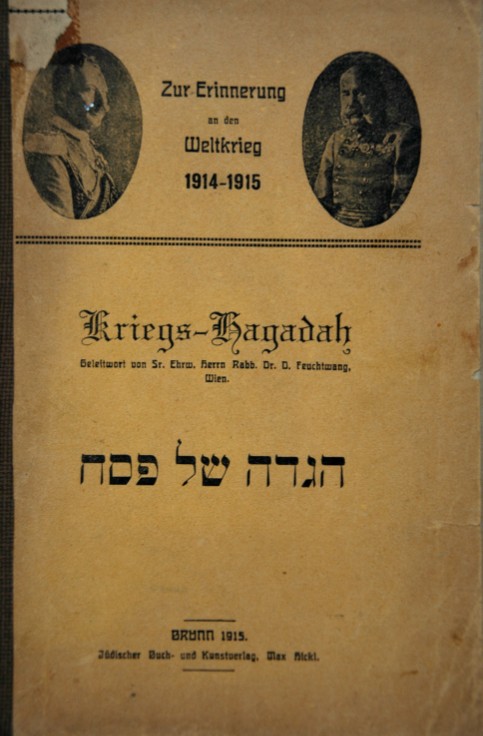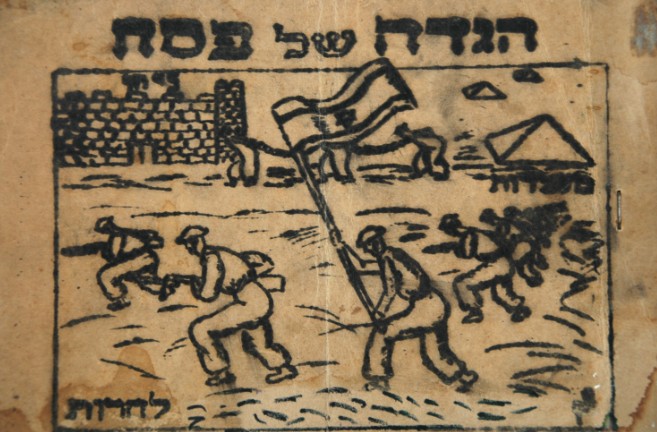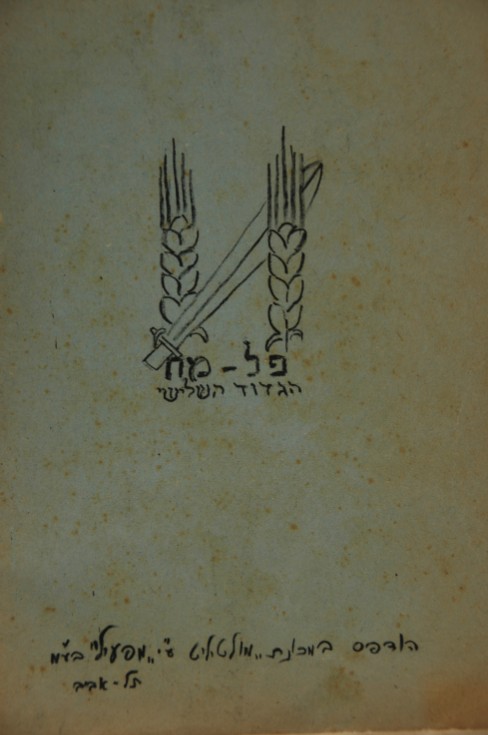The Haggadahs that Tell Our Stories: More than Pharaoh We Overcame
Aviram Paz collects Haggadahs of Jewish soldiers, refugees, concentration camp survivors, and fighters in besieged cities during the War of Independence. Haggadahs in which readers deeply identified with the Exodus from Egypt and also hoped for redemption.

Aviram Paz started collecting Haggadahs out of an interest in Jewish art. However, as the collection grew, Paz found himself embarking on a fascinating historical journey into the history of the Jewish people over the last century.
"Initially, I focused on traditional Haggadahs and loved seeing the differences in types of illustrations and design," he shares. "But then I purchased a collection where I discovered a unique Haggadah of soldiers, and my interest in this sub-genre was ignited."
The story of the Exodus from Egypt was, for many generations of Jews, not only a biblical narrative about their ancestors but a story that resonated with their personal experiences of that time. Consequently, tens and hundreds of unique Haggadahs were created - of Jewish soldiers, refugees, or concentration camp survivors - who incorporated into the original Haggadah text details of their own lives, their distress in their 'Egypt' of that time, and the salvation and miracles they witnessed. Recently, after 20 years of research in the field, Aviram Paz released a book focusing on one hundred Haggadahs from his collection.
 Aviram Paz
Aviram Paz"The oldest Haggadah I have of this kind is a Haggadah from World War I," says Paz. "It is a Haggadah issued by the Austro-Hungarian army for its Jewish soldiers, and on the cover, there are pictures of Franz Joseph, Emperor of Austria, and Wilhelm, Emperor of Germany." From World War I, Haggadahs also survived from the Jewish regiments in the British army that participated in the fighting, including the regiment of Joseph Trumpeldor.
From the period of World War II, there are many more Haggadahs. "There is a very interesting Haggadah from the British army's surveying unit. Jews from Eretz Yisrael who enlisted in the British army found themselves in an exceptional conflict: on one hand, they very much wanted to fight the Nazis who sent their family members to concentration camps, yet on the other, they were very aware that the British closed the gates of the land, preventing European Jews from escaping. Their relationship with the British army in which they served was ambivalent, and this is reflected in the Haggadah and its illustrations." Jewish soldiers in the US army also had their own Haggadahs. But perhaps the most interesting Haggadah from that period is the one from Theresienstadt camp.
Theresienstadt camp was not a typical camp, as the Nazis used it as a kind of ‘model ghetto’ which they showcased to delegates like the Red Army delegation. Accordingly, prisoners in the camp had more opportunities to celebrate the seder. "The woman responsible for organizing a modest seder in Theresienstadt kept the Haggadah they wrote especially for that year, and she gave it to me years later," says Paz.
Many interesting Haggadahs emerged in the displaced persons camps after the Holocaust, when Holocaust survivors celebrated seder in the years they temporarily lived in Europe, waiting either for aliyah to Eretz Yisrael or for an immigration visa to the United States, Australia, or another friendly country. In Paz's collection, ‘The Klauser Haggadah’ is included, which has a particularly interesting story behind it.
 Passover Haggadah for Jewish Soldiers in the Austro-Hungarian Army 1915
Passover Haggadah for Jewish Soldiers in the Austro-Hungarian Army 1915"Rabbi Klauser was the chief military rabbi of the Fifth United States Army. In 1946, he arrived with the army at the Landsberg displaced persons camp in Munich. He wanted to conduct a seder in the Munich theater building, and among other things, needed to organize Haggadahs. As he walked around the camp, he found a Haggadah that the camp people had already independently produced, known as the ‘Shinzon Haggadah’. He took it, added two pages of Torah insights, printed the Fifth Army’s emblem on the cover – and that was the official Haggadah of the 1946 seder in Munich.
“Years later, people wanted to make a facsimile of this Haggadah but could not discover who the artist behind it was. The illustrations there are very harsh, depicting Nazis tormenting Jews in various ways. The artist’s name appeared as ‘Ben Binyamin’, and no one knew who he was. Yad Vashem approached me asking for help in uncovering the artist’s identity.
 Haggadah of the 405th Water Company in Benghazi Libya 1943
Haggadah of the 405th Water Company in Benghazi Libya 1943Luckily, after a search, I came across a small booklet produced by refugees with the same style drawings, bearing the name of the artist ‘Andre Miklos’ alongside ‘Ben Binyamin’, which led us to understand that ‘Ben Binyamin’ was an artistic pseudonym behind which the artist Andre Miklos hid. I sent the evidence to Yad Vashem, and thus the mystery was solved."
Another category of Haggadahs collected by Paz is 'Refugee Haggadahs' – Haggadahs produced by those who were detained almost within reach of the land, and were naturally very identified with the wanderings of the Israelites in the desert. "In Cyprus alone eight Haggadahs were issued. There are also Haggadahs produced by groups of the Haganah and Palmach who went to Europe to train the Ma’apilim in camps. In Rome, there was a platoon of the Gideonites – couriers who accompanied the ships of the illegal immigrants. They also conducted a seder and produced their own Haggadah.
"A Haggadah was also issued in Atlit in the land. Those who produced the Haggadah actually told the story of the ship ‘Hilda’ – 730 Jews who reached the land after a journey fraught with difficulties and disasters, and after many efforts, the agency managed to bring them to Atlit, at least. They wrote the Haggadah in German, with pen and notebook. The Haggadah was later smuggled to a printing house in Haifa, typed there, and published, and the original returned to Atlit. This Haggadah is also in my collection."
Another chapter in Paz's book discusses the Haggadahs published during the siege days of the War of Independence. "There is a Haggadah for Jerusalem in the siege. There is a Haggadah for Ben Shemen in the siege. The Ben Shemen Haggadah is a particularly interesting story: supplies could not be sent to them because Ben Shemen was surrounded by Arab villages and the fighters there fired on every Israeli plane that tried to land in Ben Shemen. They produced a Haggadah in stencil and were unsure how they would have food for the holiday. Eventually, a Piper aircraft piloted by Zviki Zibel managed to land, bringing them supplies and real Haggadahs. On the original Haggadah they had prepared, they wrote then: ‘Let this Haggadah remain for us as a memory of the order’.
 The Haggadah of the Third Battalion of the Palmach Mount Canaan - Safed 1948
The Haggadah of the Third Battalion of the Palmach Mount Canaan - Safed 1948"Zibel, who brought the supplies and the Haggadahs, later received the highest mark of honor. Not only was he risking a landing - but taking off again was also extremely dangerous, and he eventually managed to do it only with a tractor parked next to him offering protection until he took off. Unfortunately, three months later, he was killed in combat."
Another Haggadah with historical timing was issued in besieged Safed. "The fighters in Safed sat on the night of the seder in the midst of the fierce fighting for the liberation of Safed. Passover came that year just days after the second failed attempt to conquer the Nebi Yusha fortress, where 22 fighters were killed. Their Haggadah accurately reflects the difficult feelings in the Jewish settlement and provides a kind of news bulletin of everything that is happening in the land: not only in Safed but also in besieged Jerusalem, in Gush Etzion, and so on and so forth."
It is no coincidence that Paz’s book is titled: 'Exodus in Those Days – At This Time'. "Jews in various periods and circumstances deeply identified with the story of the Exodus," concludes Aviram Paz. And as part of this identification, they intertwined their own stories into the narrative, undoubtedly feeling how the Passover Haggadah was relevant to their lives. Indeed, in those days – and at this time.

